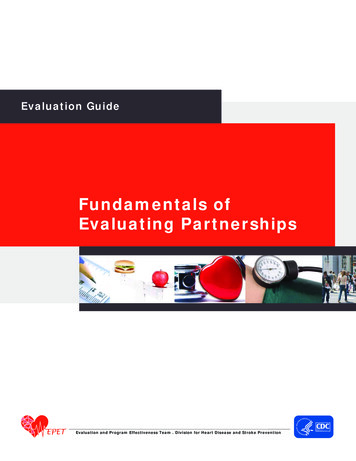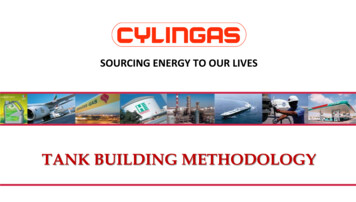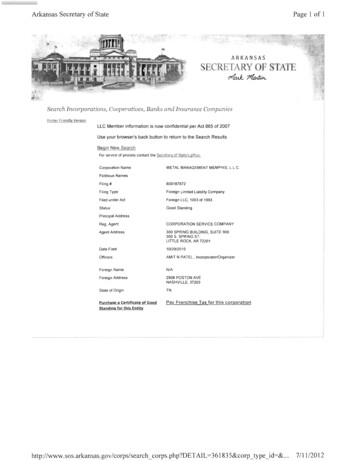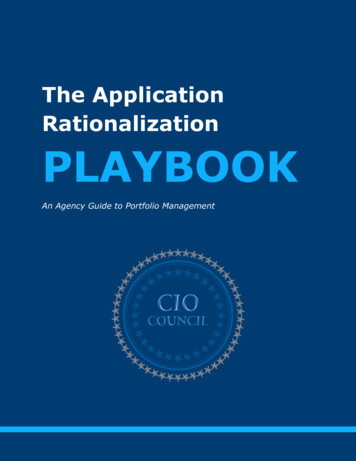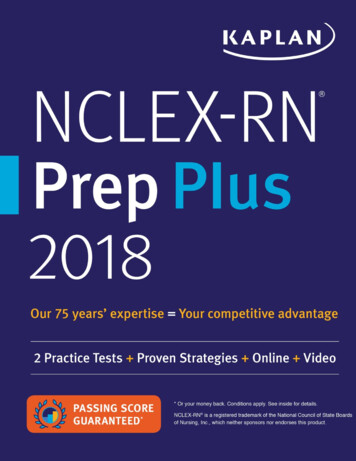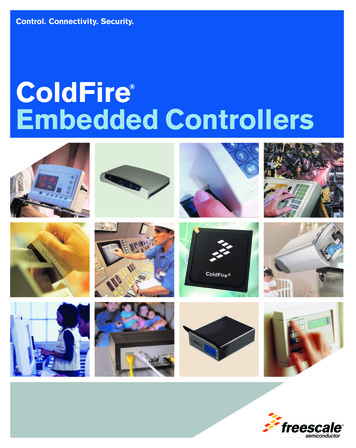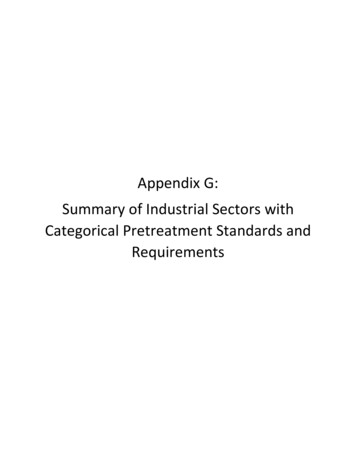
Transcription
Appendix G:Summary of Industrial Sectors withCategorical Pretreatment Standards andRequirements
Chapter 3. Pretreatment StandardsATTACHMENT 3-1: SUMMARY OF CATEGORICAL STANDARDSEPA has established categorical pretreatment standards (for indirect dischargers) for 35categories. Plans for EPA’s expansion and modification of the list are detailed in the Effluent GuidelinesPlan, published in the Federal Register biennially as required at CWA section 304(m). The list of theindustrial categories that have categorical pretreatment standards—Pretreatment Standards for ExistingSources (PSES) and Pretreatment Standards for New Sources (PSNS)—as of March 2011 is providedbelow.No.123456789Summary of categorical pretreatment standards40CFRType ofCategoryPartSubparts standardOverview of pretreatment standardsAluminum Forming 467A–FPSESLimits are production-based dailyPSNSmaximums and monthly averages.Subpart C prohibits discharges fromcertain operations.Battery461A–GPSESLimits are production-based dailyManufacturingPSNSmaximums and monthly averages. Nodischarge is allowed from any processnot specifically identified in theregulations.Carbon Black458A–DPSNSLimits are for oil and grease only (noManufacturingduration specified).Centralized Waste437A–DPSESLimits are concentration-based dailyTreatmentPSNSmaximums and monthly averages.Coil Coating465A–DPSESLimits are production-based dailyPSNSmaximums and monthly averages.Concentrated412BPSNSDischarge of process wastewater isAnimal Feedingprohibited, except when there is anOperations (CAFO)overflow resulting from a chronic orcatastrophic rainfall event.Copper Forming468APSESLimits are production-based dailyPSNSmaximums and monthly averages.Electrical and469A–DPSESLimits are concentration-based dailyElectronicPSNSmaximums and 30-day averages orComponentsmonthly averages (varies per subpartand pollutant parameter). Certification isallowed in lieu of monitoring for certainpollutants when a management plan isapproved and implemented.Electroplating413A,B,D–HPSESLimits are concentration-based (oralternative mass-based equivalents)daily maximums and four-consecutivemonitoring-days averages. Two sets oflimits exist, depending on whether facilityis discharging more or less than 10,000gpd of process wastewater. Certificationis allowed in lieu of monitoring for certainpollutants when a management plan isapproved and implemented.Introduction to the National Pretreatment Program3-9
Chapter 3. Pretreatment Standards40CFRPart418Type 11GlassManufacturing426HK–MPSNS12Grain Mills406APSNS13Ink ng415PSESSubpartsA–GIron and SteelManufacturingLeather Tanningand –F, AXBB,BC,BH,BK–BOA–F, H–J,LA–I17Metal Finishing433APSESPSNS18Metal Molding andCasting464A–DPSESPSNS19Nonferrous MetalsForming and ESPSNSOverview of pretreatment standardsLimits may specify zero discharge ofwastewater pollutants (Subpart A),production-based daily maximums, and30-day averages (Subparts B–E), ormay be concentration-based (SubpartsF–G), with no duration of limit specified.Limits are concentration- or productionbased daily maximums and monthlyaverages.Discharge of process wastewater isprohibited at a flow rate or mass loadingrate (BOD5 and TSS) that is excessiveduring periods when a POTW isreceiving peak loads.Regulations specify no discharge ofprocess wastewater pollutants to aPOTW.Limits vary for each subpart with amajority of the limits concentrationbased, daily maximums, and 30-dayaverages, or they may specify nodischarge of wastewater pollutants.Limits are production-based dailymaximums and 30-day averages.Limits are concentration-based dailymaximums and monthly averages. Incertain instances, applicability ofpretreatment standards is dictated byvolume of production.Limits are concentration-based dailymaximums and monthly averages.Certification is allowed for certainpollutants where a management plan isapproved and implemented.Limits are primarily production-baseddaily maximums and monthly averages.Discharges from certain processes areprohibited (Subparts A–C).Limits are production-based dailymaximums and monthly averages. Insome instances, the discharge ofwastewater pollutants is prohibited.Introduction to the National Pretreatment Program
Chapter 3. Pretreatment StandardsNo.20CategoryNonferrous ,V,X,Y,AA–ACType ofstandardPSESA–Z,AA–AEPSNS21Oil and GasExtraction435DPSESPSNS22Organic Chemicals,Plastics, andSynthetic Fibers414B–H, KPSESPSNS23Paint Formulating446APSNS24A–DPSNS25Paving and Roofing 443Materials (Tars andAsphalt)Pesticide Chemicals 455A, C, EPSESPSNS26Petroleum SPSNSIntroduction to the National Pretreatment ProgramOverview of pretreatment standardsLimits are production-based dailymaximums and monthly averages.PSES (Subpart F) specify no dischargefrom existing facilities of processwastewater pollutants to the POTWexcept for some stormwater events.Limits are production-based dailymaximums and monthly averages.PSNS (Subparts D and F) specify nodischarge from existing facilities ofprocess wastewater pollutants to thePOTW.Regulations specify no discharge ofwastes (e.g., produced water, drillcuttings) to a POTW.Limits are mass-based (concentrationbased standards multiplied by processflow) daily maximums and monthlyaverages. Standards for metals andcyanide apply only to metal- or cyanidebearing wastestreams.Regulations specify no discharge ofprocess wastewater pollutants to thePOTW.Limits are for oil and grease only (nolimit duration specified).Limits are mass-based (concentrationbased standards multiplied by processflow) daily maximums and monthlyaverages. Subpart C specifies nodischarge of process wastewaterpollutants but provides for pollutionprevention alternatives. Subpart Especifies no discharge of processwastewater pollutants.Limits are concentration-based (ormass-based equivalent) dailymaximums.Limits are concentration-based dailymaximums and monthly averages. Suchfacilities may certify that they do not useor generate cyanide in lieu of performingmonitoring to demonstrate compliance.Limits are concentration-based (oralternative production-based) dailymaximums and monthly averages.Subpart B prohibits discharges fromcertain operations.3-11
Chapter 3. Pretreatment Standards40CFRPart430SubpartsA–G, I–LType ofstandardPSESPSNSNo.29CategoryPulp, Paper, ap and Detergent 417ManufacturingO–RPSNS32Steam ElectricPower Generating423—PSESPSNS33Timber 442Equipment CleaningA–CPSESPSNS35Waste CombustorsAPSESPSNS3-12444Overview of pretreatment standardsLimits are production-based dailymaximums and monthly averages. Suchfacilities may certify that they do not usecertain compounds in lieu of performingmonitoring to demonstrate compliance.Facilities subject to Subparts B and Emust also implement BMPs as identified.Limits are concentration- or productionbased daily maximums and monthlyaverages.Regulations specify no discharge ofprocess wastewater pollutants to aPOTW when the wastewater chemicaloxygen demand (COD)/BOD7 ratioexceeds 10.0 and the CODconcentrations exceed subcategoryspecific concentrations.Limits are concentration-based dailymaximums, or maximums for any time,or compliance may be demonstratedthrough engineering calculations.All PSNS (and PSES for Subpart F)prohibit the discharge of wastewaterpollutants. PSES for Subparts G and Hare concentration-based dailymaximums (with production-basedalternatives).Operators subject to effluent guidelinesin subparts A–B must either meetconcentration-based daily maximumstandards or develop a PollutantManagement Plan. Operators subject toeffluent guidelines in subpart C mustmeet concentration-based dailymaximum standards.Limits are concentration-based dailymaximums and monthly averages.Introduction to the National Pretreatment Program
Limits may specify zero discharge of wastewater pollutants (Subpart A), production-based daily maximums, and 30-day averages (Subparts B–E), or may be concentration-b





